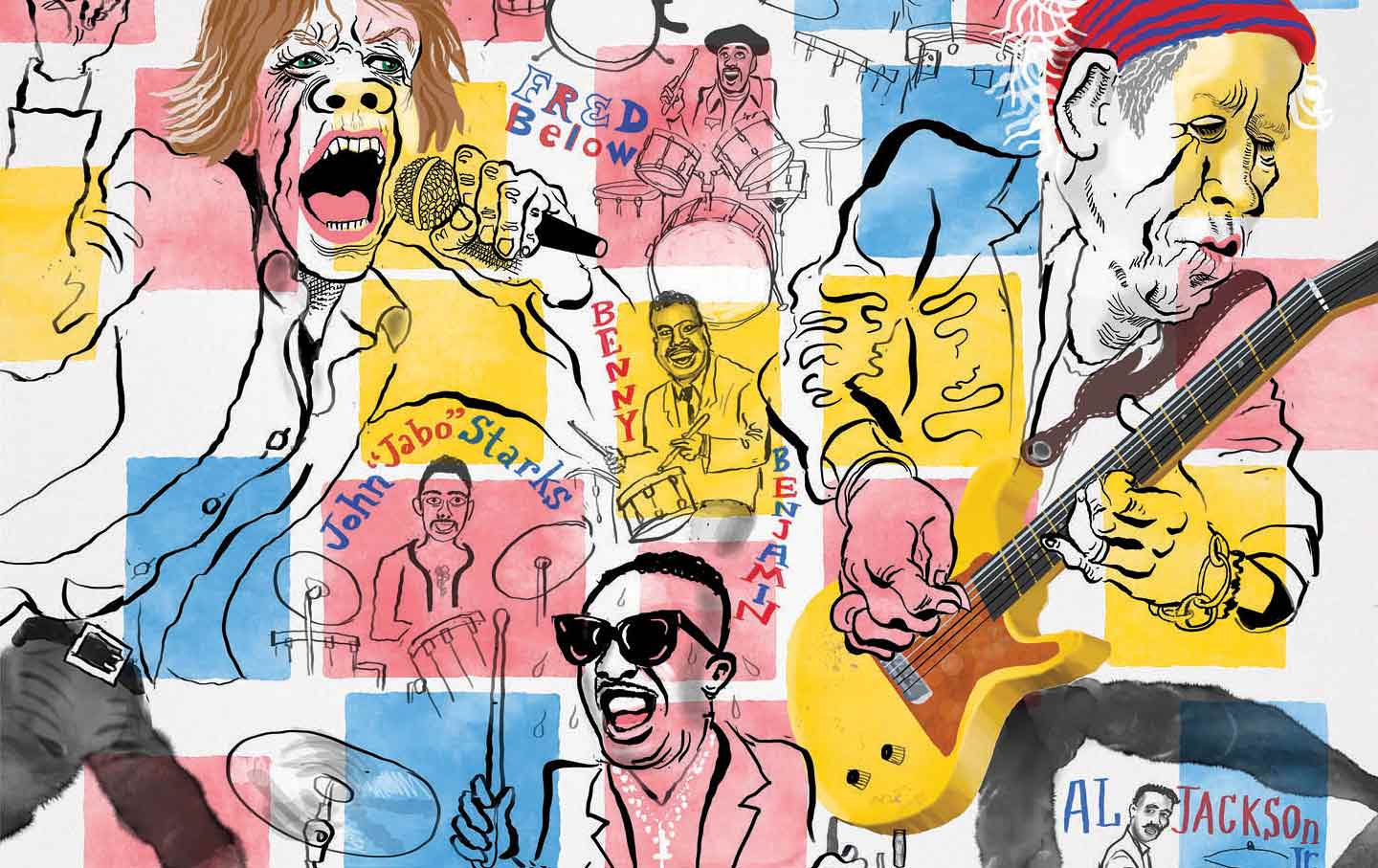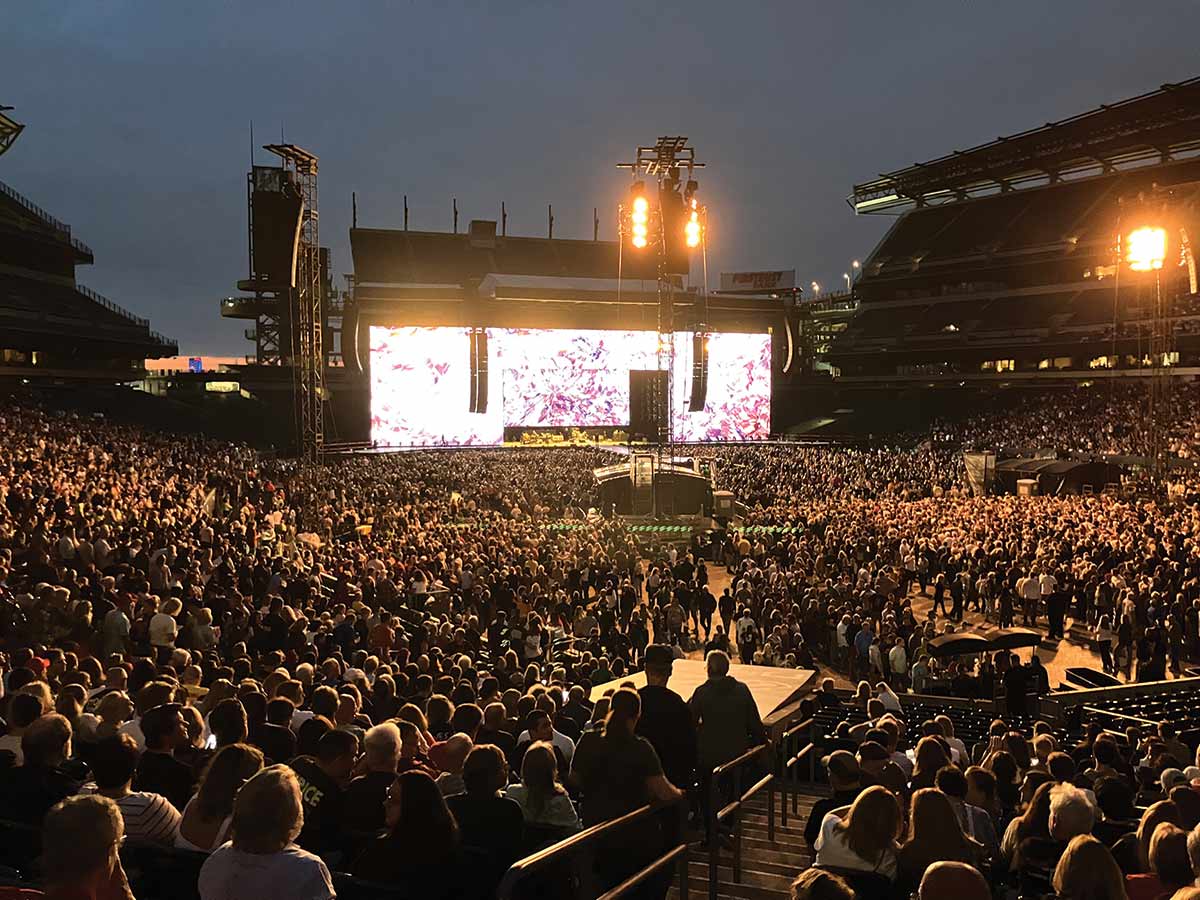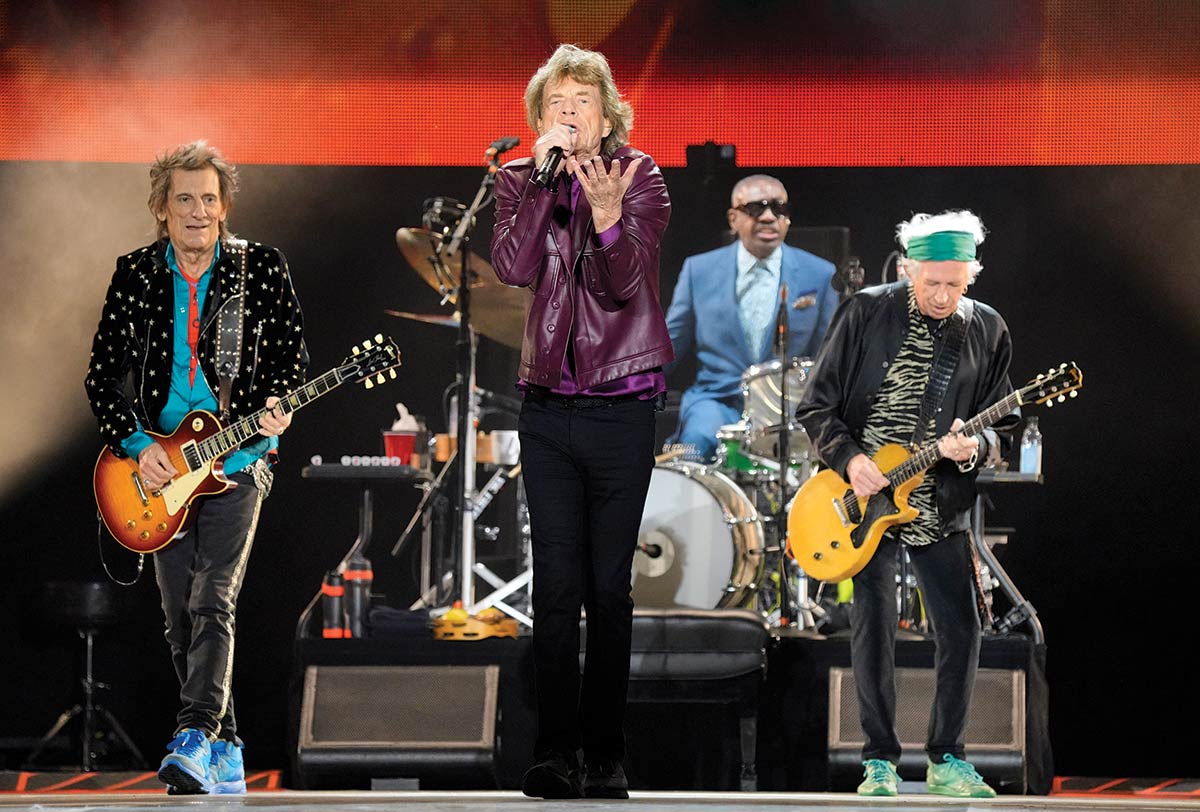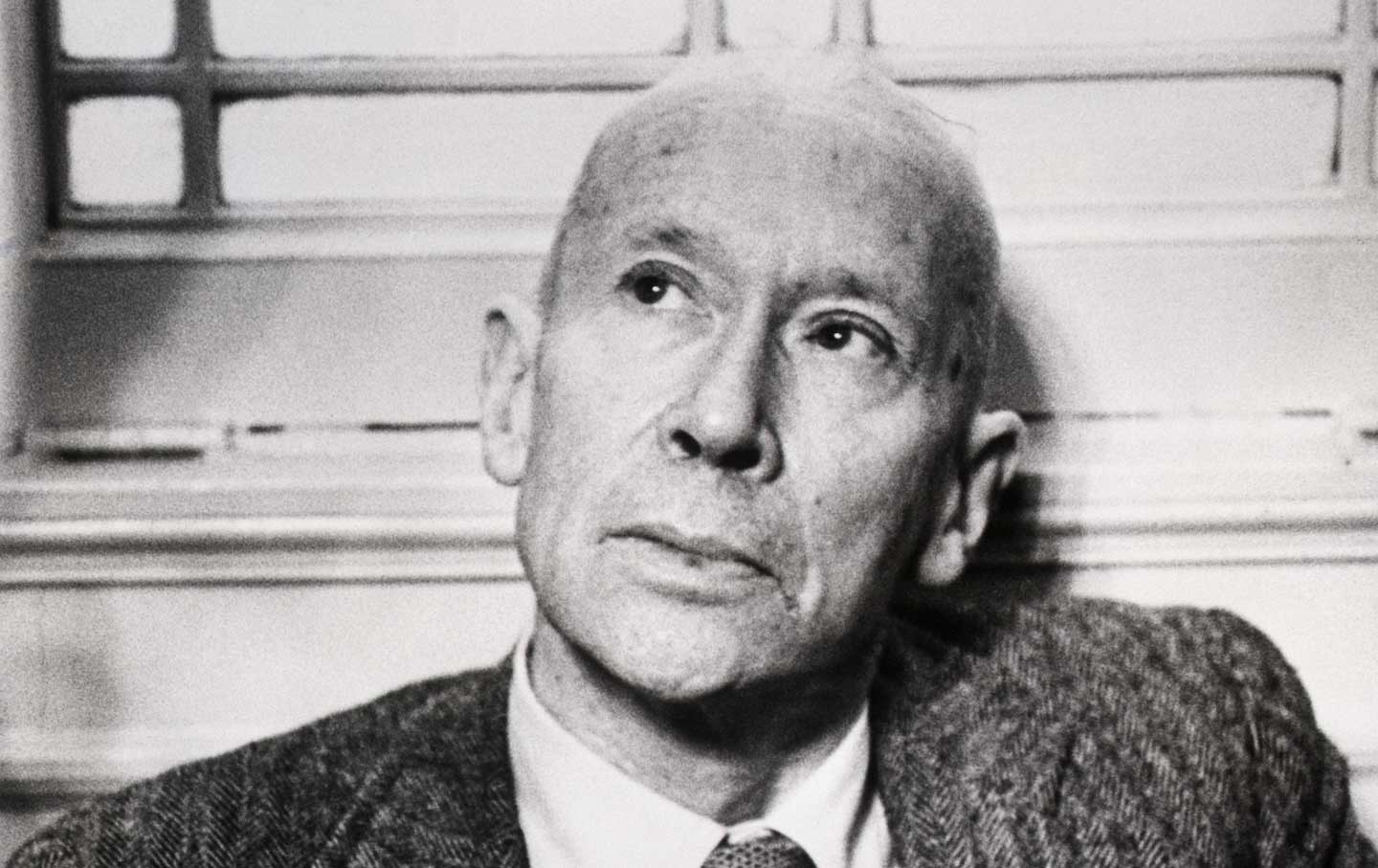
Sixty years after their first American tour, the Rolling Stones are on the road again. This time around, they’ve got a new drummer.
The world’s greatest rock and roll band is on the road again. This time, they’ve got a new drummer.
Mick Jagger and Keith Richards both turned 80 last year. Their first performance together was in the summer of 1962, or well over a year before the Kennedy assassination. On the microphone at Lincoln Financial Field in South Philadelphia, where I joined 60,000 other people still eager to see the Rolling Stones in 2024, Jagger told us he could remember an early Stones gig in Philly in 1965.
Some people grumble that these old men shouldn’t still be getting up there and peacocking like vain and troubled teenagers. It’s a fair point. Jagger and Richards are the only original members of the band, and over the years they’ve become more or less synonymous with the whole outfit. Any ensemble still in operation for six decades is bound to have some casualties, the first in this case being founding guitarist Brian Jones, a hard partyer who drowned in his swimming pool in 1969, and the latest being drummer Charlie Watts, who died at the age of 80 in 2021. A lot happened in between.
From my corner of the bleachers at Lincoln Field, some 180 yards away from the stage, the band seemed to be made up of tiny figures, and were more discernible on the massive high-definition screen. Aside from a few songs from their latest album, Hackney Diamonds, the band mostly delivered the hits, nine of them collected on the definitive anthology Hot Rocks 1964–1971. Jagger and Richards cowrote most of this classic material, though bandmates like Jones and bass player Bill Wyman contributed melodies and harmonies. These hits are familiar to multiple generations, and may well be part of the very texture of human existence.
I’d traveled to the concert with two of my best friends from high school, Wilson and Tim. We’re all in our early 50s, and it seemed like a good time for a bonding ritual that guys our age have been undertaking for decades. Much of the audience shared our demographic, and all of us seemed to be transported. Certain moments of the show exhibited sheer pageantry, as in the evening’s rendition of “Sympathy for the Devil.” The idea that rock and roll is aligned with sin, Satan, and bad-boy behavior is banal. Yet it is also the truth. When Jagger thundered out, “Please allow me to introduce myself,” the lights turned a burning red and the whole stadium sang along.
Like most other significant recording artists, the Stones invested a lot of time and energy in studio magic when crafting their hits. But the live gig has always been the live gig. They set up and they play: No synthesizers glamming up their sound, no click track in earpieces keeping their beat in line. The front line is the grizzled veterans: Jagger in the spotlight, Richards with his idiosyncratic tunings, and second guitarist Ronnie Wood as bluesy foil. However, much of the heavy lifting is done by pianist and longtime music director Chuck Leavell; bassist Darryl Jones, a Miles Davis alumnus who joined the band’s first tour after Wyman’s retirement in 1993; and the newest member, Steve Jordan, who replaced Charlie Watts.
The first requisite of a great band is a great drummer, and the Stones were lucky to land Jordan, whose numerous past credits include not only rock icons Bob Dylan, Bruce Springsteen, and Neil Young but major figures in jazz (Herbie Hancock, Sonny Rollins, Don Pullen) and R&B (Stevie Wonder, Alicia Keys, Beyoncé). His association with the Stones dates back to the 1980s, when, after a couple of one-off collaborations, he became the drummer and principal cowriter on Keith Richards’s solo albums. As Richards recounts in his memoir, Life, Watts himself noticed Jordan as far back as 1978, when the young drummer was part of the Saturday Night Live band and the Stones appeared as musical guests. Years later, Jordan was jointly chosen by Richards and Chuck Berry for the backing band in the documentary and concert film Hail! Hail! Rock ‘n’ Roll. There could be no higher credentials for the seat he now holds.
Rock and roll has a basic orientation, a North Star, its first breath, the om. It is the backbeat, the “crack” played on the snare drum on beats two and four. At Lincoln Field, the great unifier was not Mick Jagger’s menacing vaudeville or Keith Richards’s ragged strum. It was Steve Jordan’s backbeat, a driving pulsation roaring out from the back of the stage.

“The definition of rock and roll is push and pull,” Jordan told me when I called him a few days after the concert. For Jordan, that feeling is conveyed in rhythm, namely the ambiguity of “straight eighths against a dotted eighth,” the latter being an asymmetrical division of the quarter-note beat. In rock and roll, he said, “there’s always back-and-forth; it doesn’t stay one or the other.”
The word for what Jordan is talking about is “feel,” an elusive topic that rarely gets discussed in technical terms, partly because it can’t be written down with traditional European music notation. Most musicians would agree that swinging jazz and grooving funk need an element of “laying back,” meaning a slight lag behind the tempo. Of course, the details vary, and the moment someone on the bandstand decides to turn a feeling into a law, that law needs to be broken. As Jordan says, “push and pull.”
Most rhythmic feel in American music comes from Africa and the Afro-Cuban diaspora. Traditional European music didn’t have much of this kind of rhythmic sophistication, but it did have a concept of “syncopation,” which Merriam-Webster defines as “a temporary displacement of the regular metrical accents in music caused typically by stressing the weak beat.” In the late 19th century, ragtime, as composed by Black musicians like Scott Joplin, brought that off-kilter syncopation to a new prominence with sparkling melodies.
The accompaniment of ragtime had a European origin. Any march or polka features an “oom-pah” in the bass clef supporting the melody—the “oom” on the strong beat, the “pah” on the weak beat; the left hand of a ragtime pianist does the same. As ragtime gave way to jazz, gospel, and early R&B, African American musicians began stressing the weak “pah” much more, almost inverting what was “weak” and what was “strong.” This accent got stronger over time, and in the 1950s it started taking over the world.
To a layperson, a backbeat might seem easy, and in some ways it is easy, at least compared to more complex Afro-Latin diasporic rhythms connected to traditional bell pattern or clave, where staggered syncopations flex like pulsating Morse code. One of the key creators of modern rock drumming was the New Orleans virtuoso Earl Palmer, who was first widely heard with legends like Fats Domino and Little Richard before going on to appear with many of the world’s most famous acts. “The backbeat came about because the public wasn’t buying jazz,” Palmer said, in a memoir written with Tony Scherman titled simply Backbeat, “so we put something in that was simpler and that’s what made the difference.”
Popular
“swipe left below to view more authors”Swipe →
Heavily syncopated African music always implied dance, and there’s little American popular music without some sort of African-based syncopation appropriate for a dance floor. A backbeat is a dance-worthy syncopation reduced to the essential.

As with anything essential, getting a backbeat right becomes an advanced topic. In the 20th century, African Americans created the template. Along with giving due credit to Earl Palmer, Jordan named more of the beat’s greatest proponents: Al Jackson Jr. of the Stax Records house band and Al Green’s band at Hi Records; Benny Benjamin, of Motown’s house band, informally known as the Funk Brothers; Fred Below, who accompanied Chess Records artists like Muddy Waters, Chuck Berry, and Bo Diddley; and James Brown drummers Clyde Stubblefield and John “Jabo” Starks, whose beats reverberate through hip-hop in the form of samples.
During the British Invasion, a group of drummers took up this topic like a consortium of mad English scientists: Ringo Starr for the Beatles, Ginger Baker for Cream, Mitch Mitchell for the Jimi Hendrix Experience, John Bonham for Led Zeppelin, and Charlie Watts for the Rolling Stones. Watts was never a flashy drummer, and he never used one of the outsize drum kits favored by many of the bands who headlined stadiums in the 1970s. As his tenure in the Stones matured into mastery, Watts worked out some of the sparest versions of the backbeat heard on record.
For right-handed drummers, the backbeat is played on the snare drum on two and four with the left hand, while the right steadily pulses eighth notes on the ride cymbal or the closed high hat. Watts’s trademark eventually became the omission of the right-hand stroke on the high hat at the point that it would normally line up with the backbeat. The jaunty flourish that resulted—a quick upswing of the right hand as the left dealt out a resounding “PAH”—seemed to epitomize the Stones’ aesthetic, with a bit of Englishness underlying the New World groove.
It was only when I spoke to Jordan that I learned that Watts did not invent that approach. “Charlie never left out the high hat in the ’60s,” Jordan said. “He started doing that in the ’70s. It was something in the air at that moment. Levon Helm and Jim Keltner did it, and now I do it too. It was especially relevant for recording. The backbeat snare explodes in the studio if the high hat is not also being played. The high hat gets into every microphone, so if you leave it out when hitting the snare, you can treat the snare however you want. Charlie does this on ‘Shattered’ and ‘Start Me Up,’ and it’s very exciting.”
Jordan has thought a lot about how to approach playing with the Rolling Stones. “Keith Richards and I are in the engine room, so to speak,” he told me. “But Darryl Jones and I have also worked closely together on the right way to make the basic groove happen. I like the way the Stones sounded on live gigs from 1971 to 1974—to me, that was one of the strongest periods of the band in terms of live energy and how they were playing as a unit, and I try to bring the spirit of that era to the gig. By now, we’re in full swing. The band has found its stride.”
Current Issue

For Jordan, much of contemporary music has lost the secret sauce for “push and pull,” often as a result of preprogrammed software that digitally homogenizes rhythm. “When you go to see live acts these days, half of what you’re hearing is sequenced in Pro Tools, which also means that the tempos don’t breathe,” he said. “The main thing is to bring an unbridled excitement to a live performance. Take ‘Jumpin’ Jack Flash’: If we stayed at the opening tempo—if I held the tempo from start to finish—it wouldn’t generate the type of excitement that’s on the record. They speed up on the studio records of ‘Brown Sugar’ and ‘Honky Tonk Women.’ This accelerando is for a reason: It’s part of the excitement of live performance. If you’re preoccupied with holding the time steady, it’s not as freewheeling. It’s restrained, which is exactly what you don’t want to do in rock and roll. There’s nothing worse in rock and roll than being too far behind the beat or slowing down.”
It’s a subtle art. Only a fellow professional would notice anything speeding up, and only an artist of Steve Jordan’s caliber could create such an effect without sounding artificial.
Jordan’s masters of the backbeat—Palmer, Jackson, Benjamin, Below, Stubblefield, and Starks—were six African American drummers. It was a reminder that the larger issue of race is not sorted in this arena. Who got paid and who got famous is a loaded subject. It’s easy for casual rock music fans to name-check Ringo Starr, Ginger Baker, and John Bonham. The James Brown drummers Clyde Stubblefield and Jabo Starks are vastly more obscure to the world at large, in spite of their ubiquity in popular music ever since the first time DJ Kool Herc alternated between two copies of Brown’s “Give It Up or Turnit a Loose,” turning Stubblefield’s drum break into an endless loop.
The Rolling Stones sit dead center in this controversy. Some cannot forgive the Stones for emulating Chicago blues records—many of them featuring Fred Below—at a talented-amateur level as they ascended to world domination. It’s beyond question that the African American architects of blues and R&B deserved not just wider acclaim but a fairer share of the immense profits their work and influence generated.
There’s no way to fix history, but to their credit, the Stones have done much more than many rock stars to keep mentioning the names of their heroes to their vast public. When the band was booked to perform on the American TV show Shindig! in 1965, they insisted that Howlin’ Wolf appear on the show as well, introducing him as the original performer of their latest hit, Willie Dixon’s “Little Red Rooster.” For the rest of his life, Charlie Watts could hardly get through an interview without praising Black jazz geniuses like Charlie Parker and Kenny Clarke. It’s well-known that the band’s name comes from a Muddy Waters song, and indeed one of the best tracks on Hackney Diamonds is Jagger and Richards’s closing duet on Waters’s “Rolling Stone Blues.”
Jagger and Richards could do literally anything with their platform and their band, and it’s no accident that they have a Black rhythm team, Darryl Jones and Steve Jordan, serious working professionals who cut their teeth playing jazz and R&B with luminaries of those fields. Jones and Jordan don’t need to prove that they can hang with Jagger and Richards—it’s the other way around. Jagger and Richards need to prove that they can walk onstage and groove with Jones and Jordan.
With that lineup in place at Lincoln Field, the Rolling Stones still sounded like the world’s greatest rock and roll band, emphasis on the word band. Afterward, my friends talked about how the already thrilling concert had ascended to electrifying new heights during that night’s version of “Honky Tonk Women.” I hadn’t noticed at the time, but Steve Jordan’s subtle accelerando must have had something to do with it. “When we get to the second chorus of ‘Honky Tonk Women,’” he told me, “I’ve already planned to pick it up, shift gears, and drive it forward.”
Thank you for reading The Nation
We hope you enjoyed the story you just read, just one of the many incisive, deeply-reported articles we publish daily. Now more than ever, we need fearless journalism that shifts the needle on important issues, uncovers malfeasance and corruption, and uplifts voices and perspectives that often go unheard in mainstream media.
Throughout this critical election year and a time of media austerity and renewed campus activism and rising labor organizing, independent journalism that gets to the heart of the matter is more critical than ever before. Donate right now and help us hold the powerful accountable, shine a light on issues that would otherwise be swept under the rug, and build a more just and equitable future.
For nearly 160 years, The Nation has stood for truth, justice, and moral clarity. As a reader-supported publication, we are not beholden to the whims of advertisers or a corporate owner. But it does take financial resources to report on stories that may take weeks or months to properly investigate, thoroughly edit and fact-check articles, and get our stories into the hands of readers.
Donate today and stand with us for a better future. Thank you for being a supporter of independent journalism.
More from The Nation

To understand the philosophical dimensions of her fiction you must read her 1961 novel The Apple in the Dark.
Books & the Arts
/
Shaj Mathew

Revisiting his first book, The Enormous Room, a reader can get a sense of everything appealing and appalling in his work.
Books & the Arts
/
David B. Hobbs

Brett Christophers’s account of the market-induced failure to transition to renewables is his latest entry in a series of books demystifying a multi-pronged global crisis.
Books & the Arts
/
Trevor Jackson